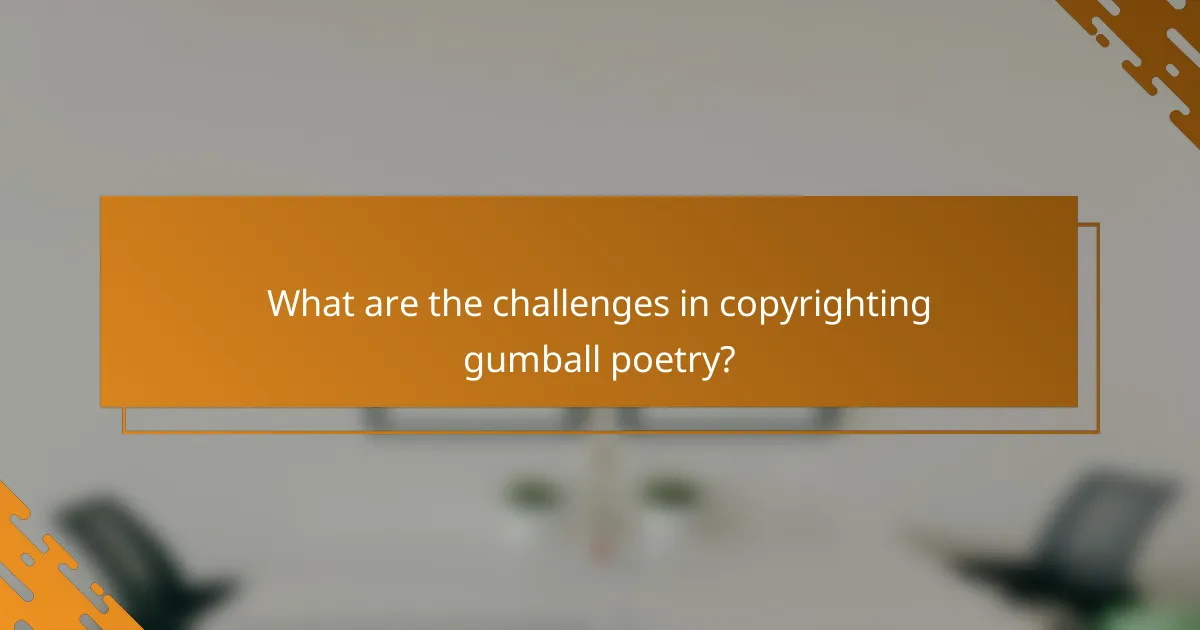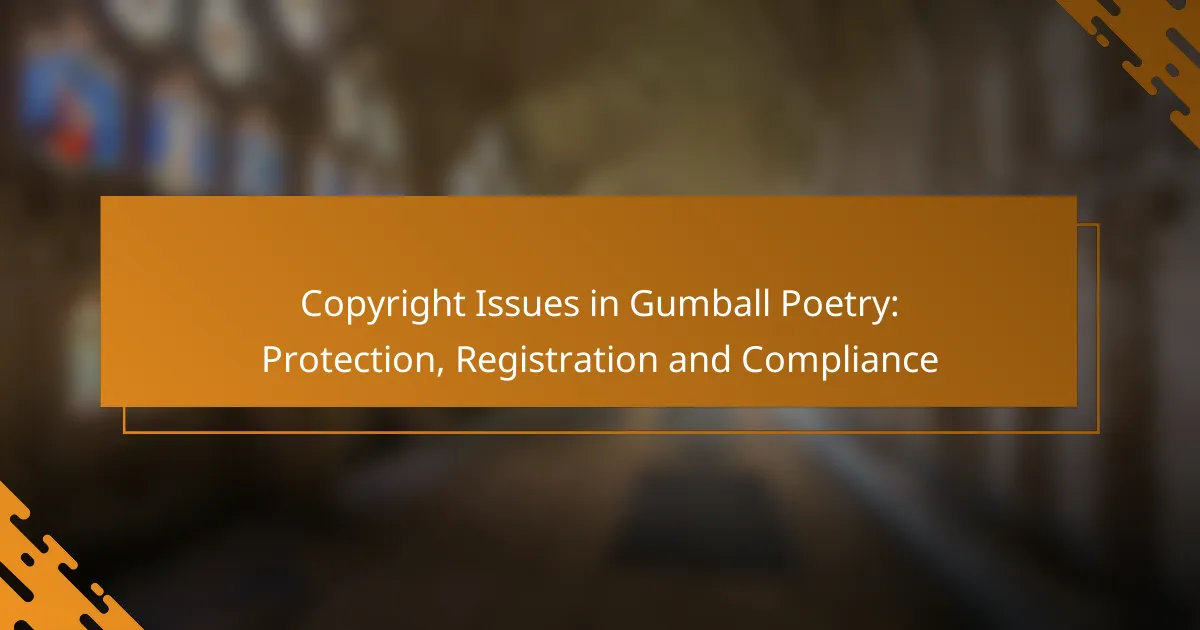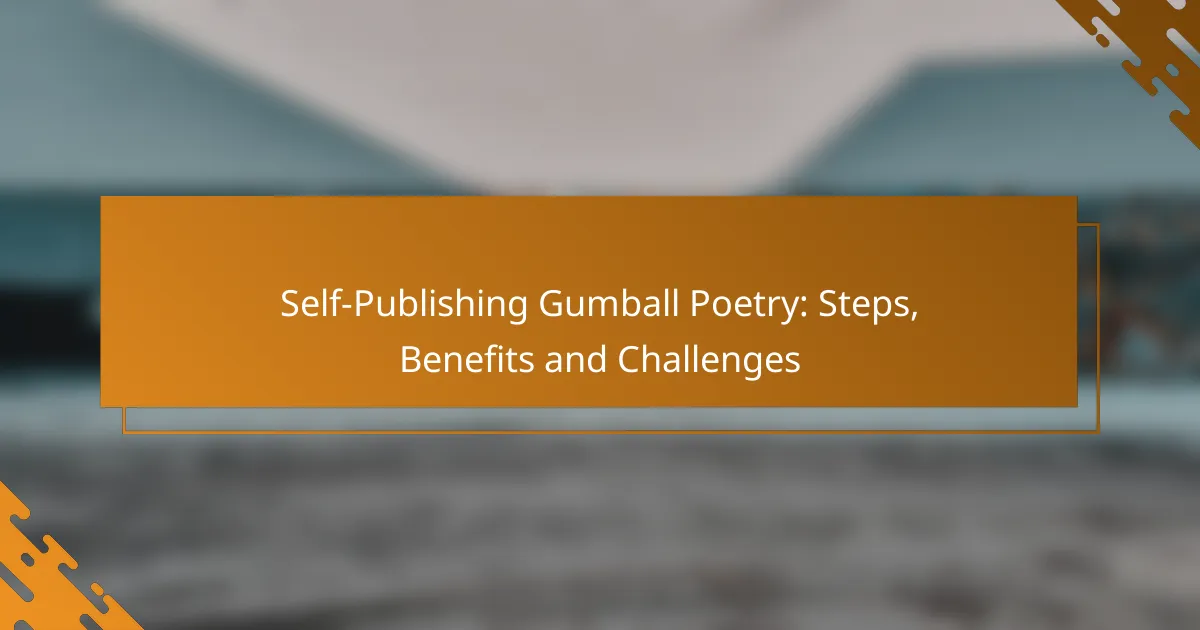Copyright issues in gumball poetry are essential for safeguarding the rights of creators and ensuring their works are properly protected. By exploring options such as formal registration with the U.S. Copyright Office and utilizing Creative Commons licenses, poets can secure exclusive rights to their creations. Additionally, understanding compliance requirements, including proper attribution and adherence to licensing agreements, is vital for maintaining the integrity of shared works.

What are the copyright protection options for gumball poetry?
Gumball poetry can be protected through various copyright options, ensuring that the creator’s rights are upheld. These options include formal registration with the U.S. Copyright Office, utilizing Creative Commons licenses, and understanding fair use considerations.
Copyright registration with the U.S. Copyright Office
Registering gumball poetry with the U.S. Copyright Office provides legal recognition and protection against unauthorized use. This process involves submitting a completed application form, a copy of the work, and a registration fee, which typically ranges from $35 to $55.
Once registered, the creator gains the ability to sue for statutory damages and attorney fees in case of infringement. It’s advisable to register as soon as the work is created to ensure maximum protection.
Creative Commons licensing
Creative Commons licenses offer a flexible way for gumball poetry creators to share their work while retaining certain rights. These licenses allow authors to specify how others can use their poetry, such as allowing modifications or requiring attribution.
Choosing the right license can enhance visibility and collaboration while protecting the creator’s interests. Options range from very permissive licenses to more restrictive ones, depending on the desired level of control.
Fair use considerations
Fair use is a legal doctrine that permits limited use of copyrighted material without permission, which can apply to gumball poetry under certain conditions. Factors influencing fair use include the purpose of use, the nature of the original work, the amount used, and the effect on the market value.
Creators should be cautious, as fair use is often subjective and can lead to legal disputes. It’s wise to seek legal advice if uncertain about whether a specific use qualifies as fair use.

How to register gumball poetry for copyright?
To register gumball poetry for copyright, you need to submit an application to the appropriate copyright office, typically the U.S. Copyright Office in the United States. This process protects your creative work and grants you exclusive rights to its use and distribution.
Steps for online registration
Begin by visiting the copyright office’s website and creating an account if you don’t already have one. Once logged in, select the option for registering a literary work, and follow the prompts to fill out the application form.
After completing the form, you will need to upload a copy of your gumball poetry. Ensure that your submission meets the required format, which is usually a digital file in PDF or DOCX format. Review your application for accuracy before submitting it.
Required documentation for registration
The primary document required for registering gumball poetry is a copy of the work itself. This should be a complete version of your poetry, showcasing your original expression.
Additionally, you may need to provide information about the authorship, such as your name, address, and the date of creation. If the work is created as part of a business, include the business name and relevant details.
Fees associated with registration
The registration fee for copyrighting gumball poetry varies depending on the method of submission. Online applications typically cost around $45, while paper submissions may be higher, often around $125.
Consider that fees can change, so check the copyright office’s website for the most current rates. If you are registering multiple works, you may be eligible for a reduced fee under certain conditions, which can save you money in the long run.

What are the compliance requirements for gumball poetry?
Compliance requirements for gumball poetry involve understanding copyright laws, ensuring proper attribution, and adhering to licensing agreements. These elements are crucial for protecting the rights of creators and maintaining the integrity of shared works.
Attribution standards for shared works
Attribution standards for gumball poetry require that creators clearly credit original authors when their work is shared or adapted. This can include mentioning the author’s name, the title of the work, and a link to the original source when applicable.
For example, if a poet uses a line from another’s gumball poem, they should include a citation that specifies the original author. Failing to provide proper attribution can lead to copyright infringement claims and loss of credibility.
Compliance with licensing agreements
Compliance with licensing agreements is essential for using gumball poetry legally. Many works are shared under specific licenses that dictate how they can be used, modified, or distributed. Familiarizing yourself with these licenses, such as Creative Commons, is critical.
For instance, a license may allow for non-commercial use only, meaning you cannot profit from the work without permission. Always check the terms of the license and ensure your use aligns with those conditions to avoid legal issues.

How to handle copyright infringement in gumball poetry?
To handle copyright infringement in gumball poetry, first identify the unauthorized use of your work, then consider legal actions to protect your rights. Understanding your options can help you effectively address violations and seek remedies.
Identifying infringement cases
Identifying copyright infringement in gumball poetry involves recognizing when your original work has been reproduced or distributed without permission. Look for instances where your unique style, themes, or specific lines appear in others’ poetry without proper attribution.
Common signs of infringement include similar phrasing, structure, or visual elements that closely resemble your creations. Keep records of your original works and any instances of suspected infringement to support your claims.
Legal actions for copyright violations
If you identify copyright infringement, you can take several legal actions to protect your gumball poetry. Start by sending a cease-and-desist letter to the infringing party, demanding they stop using your work. This letter should clearly outline your rights and the specific infringements.
If the issue is not resolved, you may consider filing a copyright infringement lawsuit. This process can vary by jurisdiction, so consult with a legal professional familiar with intellectual property laws in your area. Be aware that litigation can be costly and time-consuming, so weigh the potential benefits against the risks before proceeding.

What are the benefits of copyright for gumball poetry?
Copyright offers significant advantages for gumball poetry, primarily by providing legal protection and enabling monetization. This protection ensures that creators can control how their work is used and shared, which is crucial in a creative landscape where originality is paramount.
Monetization opportunities
Copyright allows gumball poets to monetize their work through various channels, such as publishing, licensing, and performance rights. For instance, poets can earn income by publishing their poems in collections or anthologies, or by licensing their work for use in educational materials.
Additionally, poets can explore digital platforms to sell their poetry directly to consumers or through subscription models. Engaging with audiences via social media can also lead to sponsorships and collaborations, further enhancing earning potential.
Protection against unauthorized use
Copyright provides gumball poets with legal recourse against unauthorized use of their work. This means that if someone reproduces or distributes a poem without permission, the poet can take action to enforce their rights. This protection is vital in maintaining the integrity and originality of their creative output.
To ensure maximum protection, poets should consider registering their work with the appropriate copyright office, as this can strengthen their claims in case of infringement. Keeping detailed records of their creations, including drafts and publication dates, can also serve as evidence of ownership.

What are the challenges in copyrighting gumball poetry?
Copyrighting gumball poetry presents unique challenges primarily due to its often playful and experimental nature. Issues such as determining originality and enforcing rights complicate the protection of these creative works.
Ambiguities in originality
One major challenge in copyrighting gumball poetry is the ambiguity surrounding originality. Gumball poetry often incorporates common phrases, cultural references, or playful language that may not be considered unique enough for copyright protection. This can lead to disputes over whether a piece is sufficiently original to qualify for copyright.
For example, if multiple poets use similar themes or structures, it can be difficult to prove that one work is distinct from another. Poets should strive to infuse personal style and unique elements into their work to enhance originality and strengthen their copyright claims.
Enforcement difficulties
Enforcing copyright in gumball poetry can be particularly challenging due to the informal and often collaborative nature of the genre. Many gumball poems are shared online, making it hard to track unauthorized use or reproduction. This widespread sharing can dilute the perceived value of the work and complicate enforcement efforts.
Poets should consider using digital tools to monitor their work online and establish clear terms for sharing. Additionally, registering their poems with a copyright office can provide a stronger legal basis for enforcement, although it may not guarantee complete protection against infringement.

How does copyright law evolve for digital poetry?
Copyright law for digital poetry is adapting to the unique challenges posed by the internet and digital distribution. As technology advances, the legal frameworks are being updated to better protect creators while addressing new forms of expression and sharing.
Impact of technology on copyright enforcement
Technology has significantly changed how copyright is enforced in the realm of digital poetry. Tools like digital watermarking and blockchain can help track ownership and usage, making it easier for poets to assert their rights. However, the ease of sharing online also increases the risk of unauthorized use, complicating enforcement efforts.
Creators should consider using platforms that offer built-in copyright protections or utilize services that help monitor their work online. Staying informed about technological advancements can empower poets to better safeguard their intellectual property.
Emerging trends in copyright legislation
Recent trends in copyright legislation are increasingly recognizing the need to protect digital works, including poetry. Many countries are exploring reforms that address the nuances of digital content, such as the European Union’s Digital Single Market Directive, which aims to enhance rights for creators in the digital space.
Poets should keep an eye on legislative changes that may affect their rights and consider registering their works with copyright offices to ensure they are protected under current laws. Engaging with advocacy groups can also provide insights into upcoming changes and how to adapt to them effectively.

What future developments can affect gumball poetry copyright?
Future developments that may impact gumball poetry copyright include changes in copyright law, advancements in technology, and shifts in public perception of creative works. These factors can influence how gumball poetry is protected, registered, and enforced against infringement.
Changes in copyright law
Changes in copyright law can significantly affect gumball poetry by altering the duration of protection or the criteria for originality. For instance, if laws evolve to extend copyright terms, poets may enjoy longer protection for their work. Conversely, stricter regulations could limit the scope of what is considered copyrightable.
It’s essential for poets to stay informed about legislative developments, as new laws can impact their rights and the enforcement of those rights. Engaging with legal experts or copyright organizations can provide valuable insights into potential changes.
Advancements in technology
Technological advancements, such as artificial intelligence and digital distribution platforms, can reshape how gumball poetry is created and shared. AI tools may assist poets in generating new works, but they also raise questions about authorship and ownership. Understanding how these technologies interact with copyright is crucial for poets.
Additionally, the rise of online platforms can facilitate wider distribution of gumball poetry, but it may also increase the risk of unauthorized use. Poets should consider using digital rights management (DRM) tools to protect their work when sharing it online.
Shifts in public perception
Public perception of gumball poetry and creative works can influence copyright enforcement and the willingness of individuals to respect intellectual property rights. As society becomes more aware of the importance of copyright, there may be greater support for protecting artists’ rights.
Poets can actively engage with their audience through social media and community events to foster appreciation for their work. Building a strong relationship with fans can encourage respect for copyright and discourage infringement.


